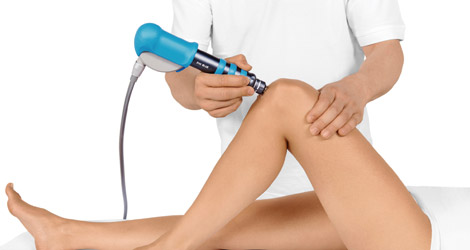Shock Wave Therapy
Shockwave therapy is a device used in orthopaedics, physiotherapy, and sports medicine. It is a non-invasive treatment that provides fast pain relief and mobility restoration. It is an ideal therapy to speed up recovery and cure various indications causing acute or chronic pain.

Mechanism of Action
Shockwave is an acoustic wave which carries high energy to painful spots and myoskeletal tissues with acute, subacute, and chronic conditions. The acoustic waves interacts with tissue causing overall medical effects of accelerated tissue repair and cell growth, analgesia and mobility restoration. The purpose of the therapy is to trigger the body's own natural healing response. Research has found that people have reported that their pain is reduced and mobility improved after the first treatment
Medical Effects
New Blood Vessel Formation
Blood flow is necessary to start and maintain the repair processes of damaged tissue structure. The application of shockwaves causes microruptures in tendon and bone, causing increased growth factors. As a result, arterioles are remodeled and stimulated to grow and new ones are formed. The new blood vessels improve blood supply and oxygenation resulting in faster healing of both the tendon and the bone.
Reversal of Chronic Inflammation
Chronic inflammation occurs when the inflammatory response is not completely halted. It can damage healthy tissue and results in chronic pain. Mast cells are one of the key components of the inflammatory process. Their activity may be increased by using pervasive acoustic waves. Mast cell activation is followed by the production of chemokines and cytokines. These pro-inflammatory compounds first enhance the inflammatory process and in the next step help restore normal healing and regenerative processes.
Stimulation Collagen Production
The production of a sufficient amount of collagen is a necessary precondition for the repair processes of the damaged myoskeletal and ligamentous structures. Shockwave therapy accelerates procollagen synthesis. The therapy forces the newly created collagen fibers into a longitudinal structure which makes the newly formed tendon fibers more dense and stiff and creates a firmer structure.
Dissolution of Calcified Fibroblasts
Calcium build-up is most often a result of micro-tears or other trauma to a tendon. Acoustic waves break up the existing calcifications. Shockwave therapy starts the biochemical decalcification of the calcium build-up of a toothpaste-like consistency and treats the tendon. The granular particles of calcium are then removed by the lymphatic system.
Dispersion of Pain Mediator
Substance P is a neurotransmitter that mediates pain information through C-fibers. This neuropeptide is generally associated with intense, persistent and chronic pain. It relays pain messages to the central nervous system. Lowering the concentration of Substance P reduces the stimulation of afferent nociceptive fibers and thus reduces the pain. Decreasing Substance P, histamines and other nociceptive metabolites also helps inhibit development of inflammatory oedema. Acoustic waves generated by Shockwave therapy lower the Substance P concentration and trigger pain relief.
Release of Trigger Points
Trigger points are the principal cause of pain in the back, neck, shoulder and limbs. They are associated with palpable nodules in taut bands of muscle fibers and have extremely contracted sarcomeres. The dysfunctional sarcomeres contract so tightly that they begin to cut off their own blood supply. This causes the waste products to build up. Waste product build-up irritates the sensory nerve endings which then causes even more contraction. This vicious cycle is referred to as “metabolic crisis”. The assumed mechanism of action is that the delivered acoustic energy unblocks the calcium pump and thus reverses the metabolic crisis in the myofilaments and releases the trigger points.
Indications
Patella Tendonitis/Jumper's knee
Painful shoulder
Lateral Epicondylitis/Tennis Elbow
Heal Spur & Plantar Fasciitis
Chronic Tendinopathy
Calcifications
Medial Tibial Stress Syndrome
Insertional Pain
Trigger point Therapy
